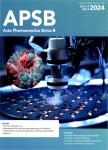Dual-responsive supramolecular photodynamic nanomedicine with activatable immunomodulation for enhanced antitumor therapy
作者机构:Key Laboratory of Tropical Biological Resources of Ministry of EducationSchool of Pharmaceutical SciencesHainan UniversityHaikou 570200China Key Laboratory of Drug-Targeting and Drug Delivery SystemWest China School of PharmacySichuan UniversityChengdu 610041China Revvity Inc.WalthamMA 02451USA School of Food and Biological EngineeringChengdu UniversityChengdu 610106China
出 版 物:《Acta Pharmaceutica Sinica B》 (药学学报(英文版))
年 卷 期:2024年第14卷第2期
页 面:765-780页
核心收录:
学科分类:100702[医学-药剂学] 1007[医学-药学(可授医学、理学学位)] 1006[医学-中西医结合] 100602[医学-中西医结合临床] 10[医学]
基 金:supported by the National Natural Science Foundation of China(82173762,China) the Key Research and Development Program of Science and Technology Department of Sichuan Province(2022JDJQ0050,China) the Fundamental of Research Funds for the Central Universities
主 题:Photodynamic therapy Immunosuppressive microenvironment Immunomodulator Dual-responsive Supramolecularassembly Checkpointblockade
摘 要:A major challenge facing photodynamic therapy(PDT) is that the activity of the immuneinduced infiltrating CD8^(+)T cells is subject to the regulatory T lymphocytes(Tregs), leaving the tumor at risk of recurrence and metastasis after the initial ablation. To augment the antitumor response and reprogram the immunosuppressive tumor microenvironment(TME), a supramolecular photodynamic nanoparticle(DACss) is constructed by the host-guest interaction between demethylcantharidin-conjugated β-cyclodextrin(DMC-CD) and amantadine-terminated disulfide-conjugated FFVLGGGC peptide with chlorin e6 decoration(Ad-ss-pep-Ce6) to achieve intelligent delivery of photosensitizer and immunomodulator for breast cancer treatment. The acid-labile β-carboxamide bond of DMC-CD is hydrolyzed in response to the acidic TME, resulting in the localized release of DMC and subsequent inhibition of *** guest molecule Ad-ss-pep-Ce6 can be cleaved by a high level of intracellular GSH, reducing photosensitizer toxicity and increasing photosensitizer retention in the tumor. With a significant increase in the CTL/Treg ratio, the combination of Ce6-based PDT and DMC-mediated immunomodulation adequately achieved spatiotemporal regulation and remodeling of the TME, as well as improved primary tumor and in situ lung metastasis suppression with the aid of PD-1 antibody.



